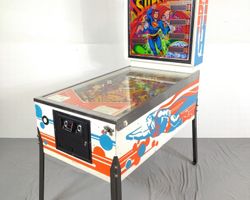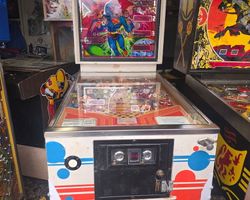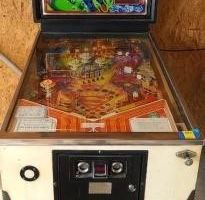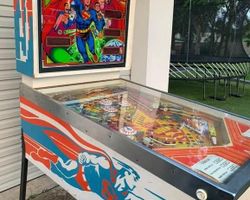Superman
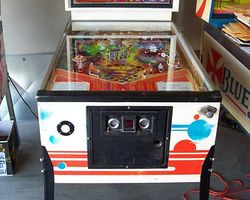
Average Prices: USD $500 to $2,300
Produced: March, 1979
Production Run: 5,124 units
Machine Type: Solid State Electronic
MPU: Atari Generation/System 2
Players: 4
Design by: Steve Ritchie
Art by: George Opperman
Sound by: Eugene Jarvis
Software by: Eugene Jarvis
The pinball machine "Superman," released by Atari, Incorporated in March 1979, represents a distinct period in solid-state pinball development. As Atari's foray into the licensed theme market, this widebody machine sought to capture the essence of the iconic DC Comics character. The design responsibilities fell to Steve Ritchie, a designer who would go on to shape significant eras of pinball. He worked closely with Eugene Jarvis, who handled the sound and software, while George Opperman crafted the distinctive artwork.
The development process for "Superman" was extensive, spanning approximately thirteen months. Ritchie detailed navigating numerous whitewood prototypes to refine the playfield layout. During this period, a notable design concept emerged: the idea of a continuous background sound. Ritchie experimented with an Echoplex unit connected to the prototype, creating an immersive aural experience that enhanced player engagement and built progressive tension. However, Atari management opted against incorporating this innovation into the final production. This concept, deemed ahead of its time by management, would later find its way into Ritchie's subsequent work at a different manufacturer, demonstrating its inherent value. Ultimately, 5,124 units of "Superman" were produced, a number that may reflect sales figures rather than the total manufactured quantity. Its release marked Atari's contribution to the burgeoning solid-state pinball era and their attempt to leverage a widely recognized intellectual property.
Signature Features and Design
"Superman" distinguishes itself through its widebody cabinet and distinctive artistic and audio presentations. George Opperman's artwork, particularly on the playfield and backglass, is a key draw. It captures the comic book aesthetic of the Man of Steel with vibrant colors and dynamic illustrations, immersing the player in the superhero theme. The widebody design, a common characteristic of machines from this era, provides an expansive playfield canvas, allowing for unique shot geometries and a different kind of playfield flow compared to standard-width machines.
Mechanically, the machine features a quartet of pop bumpers and a pair of spinning targets, elements that provide immediate, satisfying feedback and score opportunities. A prominent five-bank of drop targets serves as a central playfield objective. One of these drop targets features a "roving lit" mechanism, where a specific target in the bank illuminates, indicating a special award for hitting it. This adds an element of strategy and precision to target shooting. Complementing these are five standup targets and five star rollovers, contributing to various scoring progressions. The machine also includes a kick-out hole, which can award points or activate special features, and a free ball return lane, allowing for skill shots or a chance to re-enter the upper playfield. Eugene Jarvis's sound design, characterized by its unique "Atari bleeps and boops," creates a singular audio landscape that, while minimalist, contributes to the machine's distinct charm and retro appeal.
Playfield and Mechanics
The "Superman" playfield layout takes full advantage of its widebody dimensions, offering a more open and deliberate playing experience. The lower playfield is anchored by two flippers, providing the primary means of interacting with the ball. Above these, the pop bumpers are strategically placed to keep the ball in motion and generate points in the upper playfield.
A defining feature is the long left lane, which incorporates a U-turn to return the ball to the top of the playfield. This shot requires accuracy and provides a satisfying progression, allowing players to reset for subsequent shots or attempt to engage the upper-level features. The central area is dominated by the five-bank drop targets, which are integral to the game's primary objective of spelling out "SUPERMAN." Adjacent to these are the five standup targets and two spinning targets, offering varied shot opportunities and scoring potential. The kick-out hole is positioned to reward precise shots, often leading to bonus awards or specific game mode activation.
The design philosophy behind "Superman" leans towards subtle shot-making. The wide-open spaces encourage players to plan their shots and control the ball rather than relying on rapid, chaotic action. The artwork throughout the playfield maintains the established comic book aesthetic, with vibrant colors outlining shot paths and thematic elements. Lighting, while simpler than later machines, highlights active targets and scoring opportunities, guiding the player through the game's objectives. The overall aesthetic is cohesive, drawing directly from the source material and creating a visually engaging environment for gameplay.
Gameplay Dynamics
The core gameplay of "Superman" revolves around a clear progression and a specific scoring objective: spelling out the word "SUPERMAN." This is primarily achieved by hitting the five-bank drop targets, which likely correspond to individual letters. The roving lit drop target mechanism further adds a layer of strategy; players might prioritize hitting this specific target to maximize their score or activate a bonus.
Beyond the main objective, the machine offers various ways to accumulate points and advance through the game. The two spinning targets provide continuous scoring as they are hit, while the five standup targets and five star rollovers contribute to bonus multipliers or specific point values. The kick-out hole serves as an award mechanism, often triggered by a skilled shot, granting points or advancing a game state. The solid-state MPU (Atari Generation/System 2) manages these mechanics, tracking scores and game progression on its digital display.
Given its widebody nature and the technology of its era, "Superman" often presents a slower-paced game. This encourages a more deliberate and controlled style of play, appealing to pinball enthusiasts who appreciate precision over speed. Strategies often involve carefully aiming for the drop targets to spell "SUPERMAN," utilizing the U-turn lane to set up repeated shots to the upper playfield, and managing the ball's flow to hit the spinning targets for continuous scoring. The machine's objectives are straightforward, yet achieving them consistently requires control and understanding of the playfield’s nuances.
Reception and Legacy
"Superman" by Atari has garnered a mixed yet generally positive reception within the pinball community, with specific points of discussion regarding its play characteristics. Its strengths are frequently attributed to the visual appeal: George Opperman's artwork, particularly the playfield and backglass, is often praised for its fidelity to the comic book theme and its vibrant, detailed execution. When properly maintained or restored, the gameplay is considered enjoyable and offers a challenge, especially for players who appreciate its more deliberate pace. The widebody design, while contributing to its slower nature, also allows for interesting shot angles and a flow that some players find engaging. Specific features like the kick-out hole and the roving lit drop target are highlighted as unique elements that enhance the gameplay experience. Furthermore, the distinct "Atari bleeps and boops" of Eugene Jarvis's sound design are viewed by some as contributing to the machine’s retro charm and uniqueness.
However, "Superman" is not without its criticisms. The most common feedback points to its speed, with many describing it as a slow-playing machine, a characteristic attributed to both its widebody design and the technological constraints of Atari's pinball systems at the time. Reliability issues are another frequent complaint; Atari pinball machines from this era are sometimes noted for being prone to breakdowns, which can detract from the player experience. The sound design, while appreciated by some for its distinctive Atari character, is considered monotonous or lacking by others, with some expressing a desire for more thematic music or a richer soundscape. Instances of weak flippers are also mentioned, occasionally making certain shots difficult to execute.
Despite these points of contention, the overall sentiment toward "Superman" remains positive, particularly among those who value its unique attributes and its place in pinball history. Its legacy is notable for several reasons. It stands as an early example of a licensed superhero theme in solid-state pinball. Furthermore, it represents a significant early design by Steve Ritchie, whose experiences working on "Superman"—including the failed attempt to implement continuous background sound—directly influenced his subsequent groundbreaking designs at another major manufacturer, demonstrating a clear lineage of innovation. Its recognition, such as being named "Best in Show" at the Michigan Pinball Expo in 2015, underscores its enduring appeal and status as a machine that, when set up optimally, provides a distinct and rewarding pinball experience for enthusiasts.
Sponsored Links
 Ebay Listings
Ebay Listings
 Auction Results
Auction Results
| Cost | Location | Date |
|---|---|---|
| USD $1,200 |  Pennsylvania, United States Pennsylvania, United States |
05 September, 2025 |
| USD $1,900 |  Maryland, United States Maryland, United States |
31 July, 2025 |
| CAD $2,250 |  Canada Canada |
17 March, 2025 |
| AUD $7,000 |  Victoria, Australia Victoria, Australia |
06 October, 2024 |
| USD $4,500 |  California, United States California, United States |
06 December, 2023 |
| USD $3,150 |  Ohio, United States Ohio, United States |
23 September, 2023 |
| USD $1,175 |  North Carolina, United States North Carolina, United States |
01 December, 2022 |
| USD $2,300 |  Ohio, United States Ohio, United States |
19 October, 2022 |
| USD $4,495 |  Colorado, United States Colorado, United States |
27 March, 2022 |
| USD $3,000 |  California, United States California, United States |
30 November, 2021 |


Private Policy · Search Website · Contact Us
As an eBay Partner, we may earn a commission from qualifying purchases made through links on this site, at no additional cost to you.
All trademarks and copyrighted materials remain property of their respective owners. All other content copyright 2007 - 2025 Pinpedia.

